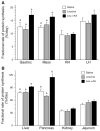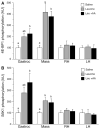Differential effects of long-term leucine infusion on tissue protein synthesis in neonatal pigs
- PMID: 20505962
- PMCID: PMC3139360
- DOI: 10.1007/s00726-010-0629-9
Differential effects of long-term leucine infusion on tissue protein synthesis in neonatal pigs
Abstract
Leucine is unique among the amino acids in its ability to promote protein synthesis by activating translation initiation via the mammalian target of rapamycin (mTOR) pathway. Previously, we showed that leucine infusion acutely stimulates protein synthesis in fast-twitch glycolytic muscle of neonatal pigs but this response cannot be maintained unless the leucine-induced fall in amino acids is prevented. To determine whether leucine can stimulate protein synthesis in muscles of different fiber types and in visceral tissues of the neonate in the long-term if baseline amino acid concentrations are maintained, overnight fasted neonatal pigs were infused for 24 h with saline, leucine (400 micromol kg(-1) h(-1)), or leucine with replacement amino acids to prevent the leucine-induced hypoaminoacidemia. Changes in the fractional rate of protein synthesis and activation of mTOR, as determined by eukaryotic initiation factor 4E binding protein (4E-BP1) and S6 kinase 1 (S6K1) phosphorylation, in the gastrocnemius and masseter muscles, heart, liver, jejunum, kidney, and pancreas were measured. Leucine increased mTOR activation in the gastrocnemius and masseter muscles, liver, and pancreas, in both the absence and presence of amino acid replacement. However, protein synthesis in these tissues was increased only when amino acids were infused to maintain baseline levels. There were no changes in mTOR signaling or protein synthesis in the other tissues we examined. Thus, long-term infusion of leucine stimulates mTOR signaling in skeletal muscle and some visceral tissues but the leucine-induced stimulation of protein synthesis in these tissues requires sustained amino acid availability.
Figures



Similar articles
-
Triennial Growth Symposium: leucine acts as a nutrient signal to stimulate protein synthesis in neonatal pigs.J Anim Sci. 2011 Jul;89(7):2004-16. doi: 10.2527/jas.2010-3400. Epub 2010 Oct 8. J Anim Sci. 2011. PMID: 20935141 Free PMC article. Review.
-
Stimulation of muscle protein synthesis by prolonged parenteral infusion of leucine is dependent on amino acid availability in neonatal pigs.J Nutr. 2010 Feb;140(2):264-70. doi: 10.3945/jn.109.113621. Epub 2009 Dec 23. J Nutr. 2010. PMID: 20032489 Free PMC article.
-
Amino acid availability and age affect the leucine stimulation of protein synthesis and eIF4F formation in muscle.Am J Physiol Endocrinol Metab. 2007 Dec;293(6):E1615-21. doi: 10.1152/ajpendo.00302.2007. Epub 2007 Sep 18. Am J Physiol Endocrinol Metab. 2007. PMID: 17878223 Free PMC article.
-
Leucine supplementation of a low-protein meal increases skeletal muscle and visceral tissue protein synthesis in neonatal pigs by stimulating mTOR-dependent translation initiation.J Nutr. 2010 Dec;140(12):2145-52. doi: 10.3945/jn.110.128421. Epub 2010 Oct 20. J Nutr. 2010. PMID: 20962152 Free PMC article.
-
Signaling pathways involved in translational control of protein synthesis in skeletal muscle by leucine.J Nutr. 2001 Mar;131(3):856S-860S. doi: 10.1093/jn/131.3.856S. J Nutr. 2001. PMID: 11238774 Review.
Cited by
-
L-tryptophan-mediated enhancement of susceptibility to nonalcoholic fatty liver disease is dependent on the mammalian target of rapamycin.J Biol Chem. 2011 Oct 7;286(40):34800-8. doi: 10.1074/jbc.M111.235473. Epub 2011 Aug 12. J Biol Chem. 2011. PMID: 21841000 Free PMC article.
-
Triennial Growth Symposium: leucine acts as a nutrient signal to stimulate protein synthesis in neonatal pigs.J Anim Sci. 2011 Jul;89(7):2004-16. doi: 10.2527/jas.2010-3400. Epub 2010 Oct 8. J Anim Sci. 2011. PMID: 20935141 Free PMC article. Review.
-
Leucine pulses enhance skeletal muscle protein synthesis during continuous feeding in neonatal pigs.Am J Physiol Endocrinol Metab. 2013 Sep 1;305(5):E620-31. doi: 10.1152/ajpendo.00135.2013. Epub 2013 Jul 9. Am J Physiol Endocrinol Metab. 2013. PMID: 23839523 Free PMC article.
-
Effects of dietary leucine supplementation on the gene expression of mammalian target of rapamycin signaling pathway and intestinal development of broilers.Anim Nutr. 2015 Dec;1(4):313-319. doi: 10.1016/j.aninu.2015.11.005. Epub 2015 Nov 18. Anim Nutr. 2015. PMID: 29767001 Free PMC article.
-
Prematurity blunts the feeding-induced stimulation of translation initiation signaling and protein synthesis in muscle of neonatal piglets.Am J Physiol Endocrinol Metab. 2019 Nov 1;317(5):E839-E851. doi: 10.1152/ajpendo.00151.2019. Epub 2019 Sep 10. Am J Physiol Endocrinol Metab. 2019. PMID: 31503514 Free PMC article.
References
-
- Anthony JC, Yoshizawa F, Anthony TG, Vary TC, Jefferson LS, Kimball SR. Leucine stimulates translation initiation in skeletal muscle of postabsorptive rats via a rapamycin-sensitive pathway. J Nutr. 2000;130:2413–2419. - PubMed
-
- Anthony JC, Anthony TG, Kimball SR, Jefferson LS. Signaling pathways involved in translational control of protein synthesis in skeletal muscle by leucine. J Nutr. 2001;131:856S–860S. - PubMed
-
- Anthony JC, Reiter AK, Anthony TG, Crozier SJ, Lang CH, MacLean DA, Kimball SR, Jefferson LS. Orally administered leucine enhances protein synthesis in skeletal muscle of diabetic rats in the absence of increases in 4E-BP1 or S6K1 phosphorylation. Diabetes. 2002;51:928–936. - PubMed
-
- Ban H, Shigemitsu K, Yamastsuji T, Haisa M, Nakajo T, Takaoka M, Nobuhisa T, Gunduz M, Tanaka N, Naomota Y. Arginine and leucine regulate p70 S6 kinase and 4E-BP1 in intestinal epithelial cells. Int J Mol Med. 2004;13:537–543. - PubMed
-
- Burrin DG, Davis TA, Ebner S, Schoknecht PA, Fiorotto ML, Reeds PJ, McAvoy S. Nutrient-independent and nutrient-dependent factors stimulate protein synthesis in colostrum-fed newborn pigs. Pediatr Res. 1995;37:593–599. - PubMed
Publication types
MeSH terms
Substances
Grants and funding
LinkOut - more resources
Full Text Sources
Other Literature Sources
Miscellaneous

